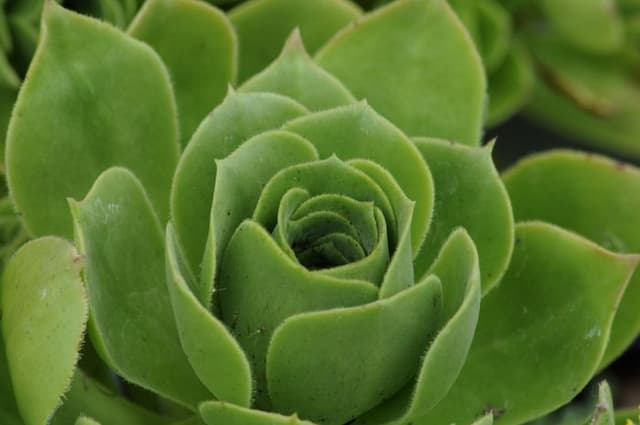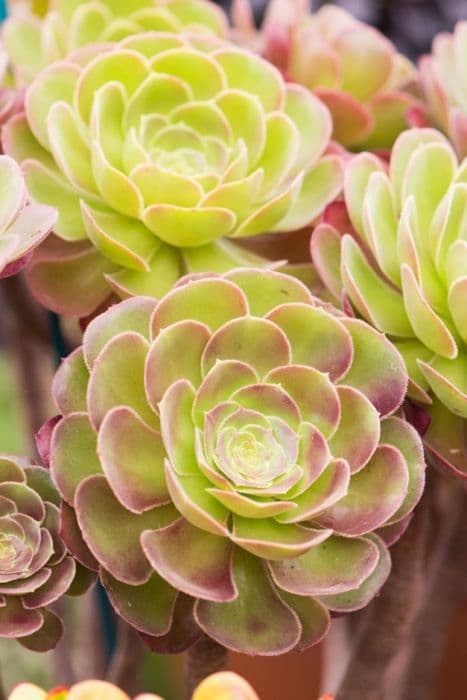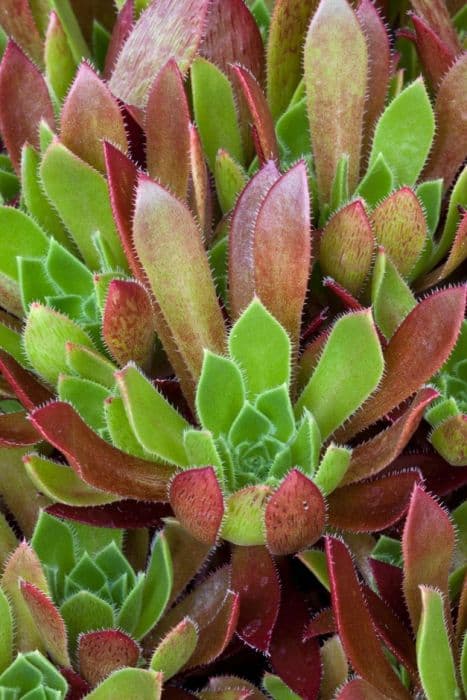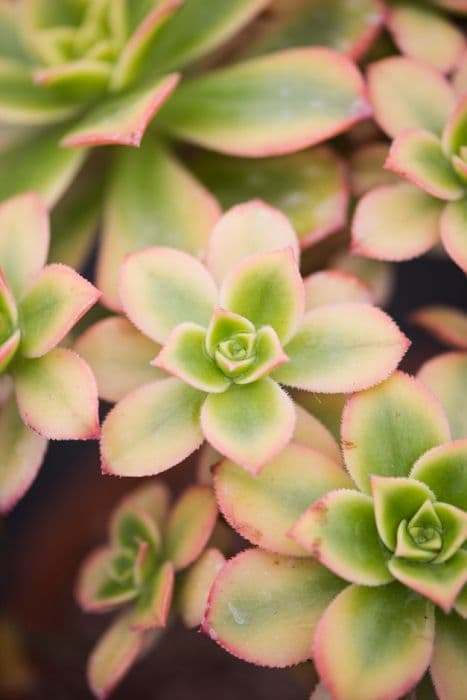Bittersweet Echeveria Echeveria 'Bittersweet'

ABOUT
The Echeveria 'Bittersweet' is a striking succulent known for its ornamental qualities. It possesses a rosette formation, with fleshy leaves that are a characteristic feature of the Echeveria genus. The leaves on this plant are distinctively shaped, each one broad at the base and tapering to a pointed tip. This creates a full and compact appearance, much like a sculpture made of living plant material. The coloration of the Echeveria 'Bittersweet' is especially appealing. It typically showcases a blend of colors, with the base of each leaf a deep green that may transition into shades of orange, pink, or even a coppery red. As with many Echeverias, the intensity of the color can be amplified by environmental factors such as exposure to sunlight or stress from limited watering. The surface of the leaves may have a soft, powdery coating known as farina, which can give the leaves a matte, slightly frosted appearance. This coating helps protect the plant from intense light and water loss. Edges of the leaves might be accentuated with a brighter color, adding dimension and depth to the plant's overall aesthetic. Texture plays a role in the allure of the Echeveria 'Bittersweet' as well. The leaves are usually plump and have a pleasing smoothness when touched, which highlights the plant's succulence and ability to retain water. The rosette is symmetrical and can be quite dense, with leaves packed together in an orderly and overlapping pattern that is pleasing to the eye. During the growing season, Echeveria 'Bittersweet' may produce flower spikes from the center of the rosette, with bell-shaped flowers in hues that complement the foliage. However, the focus of appreciation for this plant is typically on the charming qualities of its rosette and foliage, which provide year-round visual interest.
About this plant
 Names
NamesSynonyms
Mexican Hens and Chicks, Mexican Snowball, Mexican Gem, Hen and Chicks, Molded Wax Agave.
Common names
Echeveria 'Bittersweet'.
 Toxicity
ToxicityTo humans
Echeveria 'Bittersweet' is generally considered non-toxic to humans. Ingesting parts of this succulent is not likely to cause poisoning or serious health issues.
To pets
Echeveria 'Bittersweet' is also deemed non-toxic to pets. It is not expected to cause any serious symptoms if ingested by cats, dogs, or other household pets.
 Characteristics
CharacteristicsLife cycle
Perennials
Foliage type
Evergreen
Color of leaves
Mixed
Flower color
Orange
Height
6 inches (15 cm)
Spread
6 inches (15 cm)
Plant type
Succulent
Hardiness zones
9
Native area
Mexico
Benefits
 General Benefits
General Benefits- Low Maintenance: Echeveria Bittersweet is easy to care for, requiring minimal watering and upkeep, making it ideal for busy plant owners.
- Drought-resistant: It can survive with little water, making it suitable for dry climates and water-conservation gardens.
- Aesthetic Appeal: With its attractive rosette shape and colorful leaves, it adds a unique visual interest to any garden or interior space.
- Suitable for Containers: It is well adapted to growing in pots, perfect for balconies, patios, and indoor spaces with limited garden area.
- Attracts Pollinators: When blooming, its flowers can attract beneficial pollinators like bees and butterflies to your garden.
- Non-toxic: It is safe for homes with pets and children, as it is not known to be toxic if ingested.
- Versatile Use: Can be used in a variety of gardening projects including terrariums, dish gardens, and as ground cover in sunny spots.
- Propagates Easily: Leaves or offsets can be easily propagated to create new plants, making it an economical and rewarding option for plant enthusiasts.
- Year-Round Interest: Evergreen in nature, it provides visual interest throughout the year, unlike seasonal plants that may die back or go dormant.
- Stress Relief: The process of caring for Echeveria Bittersweet can provide a therapeutic benefit, offering a calming and relaxing hobby.
 Medical Properties
Medical PropertiesThis plant is not used for medical purposes.
 Air-purifying Qualities
Air-purifying QualitiesThis plant is not specifically known for air purifying qualities.
 Other Uses
Other Uses- Echeveria 'Bittersweet' can be used as a living mulch in a garden bed, helping retain soil moisture and suppress weeds.
- The plant is ideal for crafting fairy gardens or miniature landscapes, with its rosettes adding a touch of whimsy and color.
- The colorful leaves of Echeveria 'Bittersweet' can be used as natural art elements in pressed flower projects or botanical prints.
- With their sculptural form, these plants are popular in floral arrangements, whether fresh or dried, offering texture and interest.
- Echeveria 'Bittersweet' can be presented as eco-friendly jewelry, such as living necklaces or brooches, when incorporated with planting mediums.
- The rosettes are used in education for teaching children about drought-resistant plants and the importance of water conservation in gardening.
- In photography, the distinctive form and coloration of these plants make them great subjects for macro photography and botanical illustration.
- This plant serves as a green roof planting option due to its low-water needs and ability to withstand full sun exposure.
- The water-wise qualities of Echeveria 'Bittersweet' allow use in xeriscaping, contributing to sustainable landscaping practices.
- As pet-friendly succulents, Echeveria 'Bittersweet' can be used in home areas where pet safety is a consideration for plant selection.
Interesting Facts
 Feng Shui
Feng ShuiThe Echeveria is not used in Feng Shui practice.
 Zodiac Sign Compitability
Zodiac Sign CompitabilityThe Echeveria is not used in astrology practice.
 Plant Symbolism
Plant Symbolism- Resilience: Echeveria, as a succulent, thrives in harsh conditions and can symbolize the ability to endure and rebound from challenges.
- Enduring Love: Due to their long-lasting nature, echeverias are often given as gifts to represent a love that can withstand the test of time.
- Beauty and Charm: With their attractive rosette shape and colorful leaves, echeverias can symbolize a subtle beauty and an understated charm.
- Adaptability: Echeveria's capacity to adapt to different environments can symbolize flexibility and versatility in life.
 Water
WaterBittersweet Echeveria should be watered deeply enough so that water runs out of the pot's drainage holes, but infrequently to mimic the drought conditions it thrives in. An average watering regime would be once every two weeks, but this can vary depending on climate and humidity—with less frequent watering in the winter months or in more humid environments. Always check that the top inch of soil is dry before watering again. It is better to err on the side of under-watering for this succulent. You can use up to a gallon of water for larger pots, but again, make sure not to water again until the soil has dried out completely.
 Light
LightBittersweet Echeveria prefers bright, indirect light for most of the day, as direct sunlight can scorch its leaves, particularly during the hottest parts of the day. A spot near a south or east-facing window is ideal, ensuring the plant receives morning light or late afternoon sun that's less intense. If grown outdoors, partial shade or filtered sunlight is recommended to protect it from intense midday rays.
 Temperature
TemperatureBittersweet Echeverias are best kept in temperatures ranging from 65 to 80 degrees Fahrenheit. They can tolerate a minimum temperature of 40 degrees Fahrenheit but should be protected from frost, as they are not frost-tolerant. During the summer, when temperatures can rise above 80 degrees Fahrenheit, it's important to ensure they have ample airflow and some protection from the hottest temperatures, such as light shade or filtered sunlight.
 Pruning
PruningPruning Bittersweet Echeveria is generally done to remove dead or damaged leaves and to maintain its shape. Prune as needed, typically no more than once a year, and it's best done in the spring or early summer at the beginning of the growing season. Use a clean, sharp pair of scissors or pruning shears, and make sure to cut close to the main stem without damaging it.
 Cleaning
CleaningAs needed
 Soil
SoilFor Echeveria 'Bittersweet', a well-draining soil mix is crucial. A blend of half succulent mix and half perlite or pumice works well. Aim for a soil pH around 6.0 to 6.5 for optimal growth.
 Repotting
RepottingEcheveria 'Bittersweet' should be repotted every two to three years or when it outgrows its container to refresh the soil and encourage healthy growth.
 Humidity & Misting
Humidity & MistingEcheveria 'Bittersweet' thrives in dry, low humidity environments typical of its natural habitat; avoid high humidity levels to prevent rot and fungal diseases.
 Suitable locations
Suitable locationsIndoor
Place in bright, indirect light and ensure pot has drainage.
Outdoor
Choose a sunny spot with afternoon shade and well-draining soil.
Hardiness zone
9-11 USDA
 Life cycle
Life cycleThe Echeveria 'Bittersweet' begins its life as a seed, germinating in well-draining soil with ample sunlight to initiate sprouting. Once sprouted, the seedling grows into a rosette, developing fleshy, spoon-shaped leaves in a tight cluster. Over time, the 'Bittersweet' rosette becomes mature and may produce offsets, also known as "pups," which can be separated to propagate new plants. It enters a blooming phase, typically in the spring or early summer, where it sends up a flower stalk with bell-shaped flowers, often attracting pollinators. After flowering, the rosette may die back, especially if it was a monocarpic variety, leaving behind the offsets to continue its legacy. These offsets will then grow to repeat the life cycle, ensuring the continuation of the species.
 Propogation
PropogationPropogation time
Spring-Early Summer
The Echeveria 'Bittersweet', commonly known as a succulent in the Echeveria genus, is best propagated during its active growth period, which is typically in the spring or early summer. The most popular method of propagation for this plant is through leaf cuttings. To do this, a healthy leaf is gently twisted off the stem, ensuring that it is a clean pull without leaving any part of the leaf on the stem. The leaf is then laid on top of a succulent or cactus potting mix and left in a bright, indirect light area. It is important to let the leaf callous over for a few days (up to a week) before placing it on the soil to avoid rotting. Roots and a new plantlet will typically begin to develop in a few weeks. Once the plantlet is substantial enough, it can then be transplanted into its own pot.









